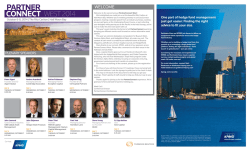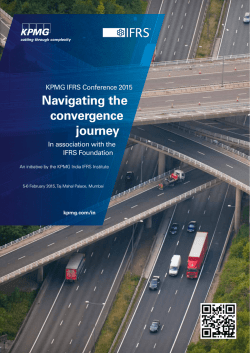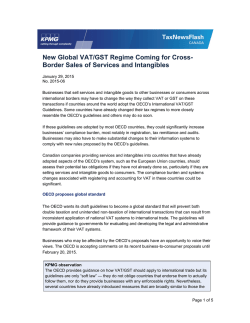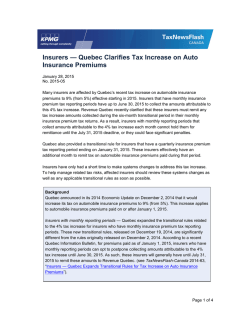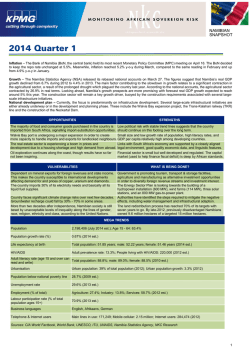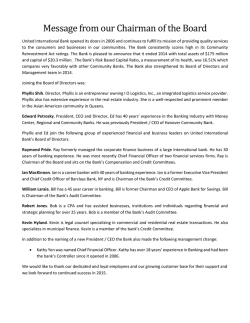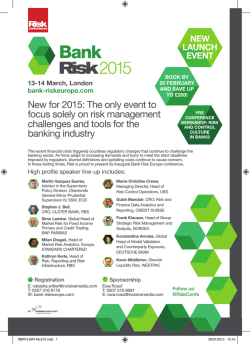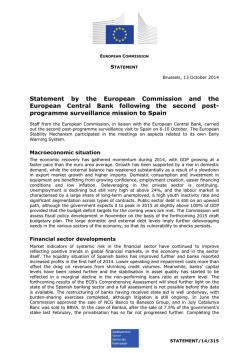
Insights | KPMG | PE
2014 Banking Industry Outlook Survey Banking on the customer kpmg.com/us/bankingindustry © 2014 KPMG LLP, a Delaware limited liability partnership and the U.S. member firm of the KPMG network of independent member firms affiliated with KPMG International Cooperative (“KPMG International”), a Swiss entity. All rights reserved. Printed in the U.S.A. NDPPS 282958 2014 Banking Industry Outlook Survey CONTENTS 3 Meeting evolving expectations 4 Detailed findings 4 Searching for sweet spots 6 Finding targeted opportunities 8 Transforming the customer experience 10 Incorporating relevant channels 12 Moving forward with mobile payments 14 Technology, technology, technology 16 Seizing growth opportunities 17 Struggling with the impact of regulation 19 Rising operating costs 20 Conclusion 20 Seeking to exceed customer expectations 21 Survey methodology © 2014 KPMG LLP, a Delaware limited liability partnership and the U.S. member firm of the KPMG network of independent member firms affiliated with KPMG International Cooperative (“KPMG International”), a Swiss entity. All rights reserved. Printed in the U.S.A. NDPPS 282958 BACK HOME NEXT 1 © 2014 KPMG LLP, a Delaware limited liability partnership and the U.S. member firm of the KPMG network of independent member firms affiliated with KPMG International Cooperative (“KPMG International”), a Swiss entity. All rights reserved. Printed in the U.S.A. NDPPS 282958 2014 Banking Industry Outlook Survey MEETING EVOLVING EXPECTATIONS Relationship banking has taken on a whole new meaning. While banks have long focused on improving their relationship with the customer, the terms of this relationship were often defined by the bank. In today’s customer-centric environment, that model falls considerably short as customers demand banking on their terms. And they know they can get what they want, if not from their bank, then from the many nontraditional market entrants who are only too happy to accommodate changing customer expectations. So, what is a bank to do? For one, they can learn a lot from their retail counterparts on how to better connect and cater to customers. They will need to align key strategic priorities to focus on providing a superior customer experience, keeping the customer at the heart of decision making every step of the way. This is relatively new territory for banks and will force their hand at trying and testing new strategies without discarding existing methods that still may serve them well. Bank executives in our 2014 Banking Industry Outlook Survey, which includes the responses of 100 senior bank executives from many of the largest banks in the United States, recognize the ongoing need for change on a strategic, operational, and structural level in order to compete now and in the future. And as our survey results indicate, despite regulatory constraints and rising costs, they are focusing efforts on developing new strategies, investing in and upgrading technology, and looking for ways to improve the customer experience more than ever before. Brian Stephens National Sector Leader, Banking & Capital Markets Brian is a partner and the national leader of KPMG’s Banking & Capital Markets practice, which serves commercial banks, regional and community banks, investment banks and securities firms, and diversified financial companies. He has 34 years of experience in the banking industry serving large multinational and national banks, as well as other global financial services institutions. © 2014 KPMG LLP, a Delaware limited liability partnership and the U.S. member firm of the KPMG network of independent member firms affiliated with KPMG International Cooperative (“KPMG International”), a Swiss entity. All rights reserved. Printed in the U.S.A. NDPPS 282958 BACK HOME NEXT 3 4 2014 Banking Industry Outlook Survey DetailedFindings SEARCHING FOR SWEET SPOTS As banks search for growth, they continue to look for areas of new opportunity as well as build upon existing ones. For example, increasing regulatory capital requirements have led many banks to focus on business areas that are less capital intensive, such as asset and wealth management. And it seems to be a successful strategy. In fact, many large institutions such as Bank of America, Goldman Sachs, J.P. Morgan Chase, Morgan Stanley, Citigroup, and Wells Fargo reported year-on-year increases in revenue at their asset and wealth management units during the first quarter of 2014.1 According to the executives in our survey, this trend is expected to continue. Thirty-two percent believe it will be the top growth driver over the next one to three years for their bank. This theme is further validated in a recent study conducted by Fidelity Investments,2 in which 55 percent of bank executives predict that revenue growth from wealth management will grow 25 percent or more in the next five years. 1 “Asset Management Units Give Banks a Boost,” by Sarah Krouse, Wall Street Journal, April 18, 2014. 2 Perspectives on Wealth Management in Banks: Insights from Pacesetters,” Fidelity Investments, March, 2014. Key takeaway: Asset and wealth management services enable banks to pursue fee generating opportunities with high-income customers that are often willing to commit funds over long periods of time. Asset and wealth management lines of business provide more opportunities for cross-selling of products and services, and banks should consider expanding and investing in this business line in key areas such as training, personnel, and marketing and sales. © 2014 KPMG LLP, a Delaware limited liability partnership and the U.S. member firm of the KPMG network of independent member firms affiliated with KPMG International Cooperative (“KPMG International”), a Swiss entity. All rights reserved. Printed in the U.S.A. NDPPS 282958 2014 Banking Industry Outlook Survey DetailedFindings Q: Which of the following areas do you believe will be the three biggest drivers of your company’s revenue growth in the next 1–3 years? 32% Asset and wealth management 28% Commercial and industrial loans Broker dealer and capital market activity 21% Cross-selling services 20% Construction lending 20% Credit cards 18% Emerging market lending 18% Residential mortgages and customer loans 17% 15% Commercial mortgages 14% New market segments (underserved) 13% Deposit fee income 12% M&A activity 9% New geographies Emerging technologies (such as mobile payments, social media) Other 7% 4% (Multiple responses allowed) © 2014 KPMG LLP, a Delaware limited liability partnership and the U.S. member firm of the KPMG network of independent member firms affiliated with KPMG International Cooperative (“KPMG International”), a Swiss entity. All rights reserved. Printed in the U.S.A. NDPPS 282958 BACK HOME NEXT 5 6 2014 Banking Industry Outlook Survey DetailedFindings FINDING TARGETED OPPORTUNITIES So, which customers hold the most opportunity? Based on the growth of asset management and wealth services, it is not surprising that the top 10 percent of income earners continue to represent the greatest growth opportunity, according to 27 percent of the executives surveyed. However, what is surprising is that more banks are also recognizing the opportunities that exist within the customer segments typically at the opposite end of the spectrum. Increasingly, the unbanked and underbanked are being viewed by banks as growing target markets, illustrated by the fact that these customer segments more than doubled in survey responses from the prior year. Other nontraditional competitors, like Walmart and PayPal, have already started gaining market share and seizing the potential opportunity from this sizable market segment. The Federal Deposit Insurance Corporation (FDIC) estimates that 8.2 percent of U.S. households (about 10 million households and 17 million adults) are unbanked, and 20.1 percent of U.S. households (about 24 million households and 51 million adults) are underbanked.3 Moreover, banks’ growing interest in such customer segments is further validated by a study conducted by Tufts University,4 which concluded that the unbanked and underbanked spend more money on fees than other customer segments. How much more? The study estimates that check cashing services generate approximately $200 million in additional annual revenue, while nearly $8 billion is earned on fees that are collected from transactions using non-home-bank ATMs. 3 FDIC “National Survey of Unbanked and Underbanked Households,” September 2012. 4 “The Cost of Cash in the United States, The Institute for Business in the Global Context,” Tufts University, 2013. Key takeaway: In our view, deploying advanced analytics will help enable banks to target customer segments and highlight potential pockets of profitability and, ultimately, serve customers better. By gaining a deeper understanding of a consumer based on data variables such as demographic, geographic, behavioral, etc., banks will be able to build customer relationships and target consumers with tailored products and services based on their needs and wants. Integrated modeling capabilities help enable the ability to deploy customized marketing, service, and sales strategies to different segments to improve response rates, customer retention, and overall business performance. © 2014 KPMG LLP, a Delaware limited liability partnership and the U.S. member firm of the KPMG network of independent member firms affiliated with KPMG International Cooperative (“KPMG International”), a Swiss entity. All rights reserved. Printed in the U.S.A. NDPPS 282958 2014 Banking Industry Outlook Survey DetailedFindings Q: Which of the following customer segments present the greatest growth opportunity for your bank? 27% Mass affluent (top 10% of income earners) Underbanked (customers without access to incremental credit) Young rising professionals5 25% 23% 12% 21% 24% Customers nearing retirement age (50–65)..................................................... 14 / 11 2014 2013 Unbanked (customers with no transaction account)......................................... 13 / 5 Retirees................................................................................................................. 2 / 5 Commercial customers................................................................................. N/A / 18 5 Upwardly mobile young professionals who earn good income, about to buy first home, etc. © 2014 KPMG LLP, a Delaware limited liability partnership and the U.S. member firm of the KPMG network of independent member firms affiliated with KPMG International Cooperative (“KPMG International”), a Swiss entity. All rights reserved. Printed in the U.S.A. NDPPS 282958 BACK HOME NEXT 7 8 2014 Banking Industry Outlook Survey DetailedFindings TRANSFORMING THE CUSTOMER EXPERIENCE Following significant changes to their business models driven by regulation, the next transformative stage will be driven by customer demand, as confirmed by 47 percent of our survey respondents. To meet the needs of today’s customer, banks will need to make the leap from a multichannel to an omnichannel approach. While the difference may seem subtle, the latter provides a greater focus on the customer, as pointed out in a recent article in Banking Technology.6 A multichannel strategy provides channel choices and encourages customers to use the one most appropriate for their needs and the 6 needs of the bank, which often translates into steering customers to the cheapest channel. Yet, moving to an omnichannel approach provides customers with a seamless experience that delivers tailored advice, products, and services. For banks, omnichannel “is an opportunity to really understand the customer, streamline systems and focus attention on the most profitable.”6 “Omnichannel: the new normal for retail banks,” by Alison Wilkes. Banking Technology, 2014. www.bankingtech.com. Key takeaway: As banks seek to rebuild trust, they can no longer rely on customer loyalty. Today’s empowered consumer is clearly driven toward getting the best rates as well as their perceived value of the best products and services. As such, banks can learn much from the best practices of leading retailers who are able to provide a superior shopping experience to their customers. To achieve similar success, banks should seek to deploy an omnichannel approach that provides the seamless integration of information and single view of the customer at every banking touch point. © 2014 KPMG LLP, a Delaware limited liability partnership and the U.S. member firm of the KPMG network of independent member firms affiliated with KPMG International Cooperative (“KPMG International”), a Swiss entity. All rights reserved. Printed in the U.S.A. NDPPS 282958 2014 Banking Industry Outlook Survey DetailedFindings Q: Over the next three to five years, what will be the top three drivers of transformation for your business? Customer demand/changes in customer focus, buying patterns, and preferences 47% 43% Coping with the change in technology 37% Domestic competition Government policy/enforcement agenda 29% Need to balance growth with shrinking budgets and increased efficiency 29% Changing or expanding global environment 29% 26% Increasing global footprint 25% Industry consolidation 18% Foreign competition Reducing the pressure on profit margins Shifting demographics away from mature economies 10% 7% (Multiple responses allowed) © 2014 KPMG LLP, a Delaware limited liability partnership and the U.S. member firm of the KPMG network of independent member firms affiliated with KPMG International Cooperative (“KPMG International”), a Swiss entity. All rights reserved. Printed in the U.S.A. NDPPS 282958 BACK HOME NEXT 9 10 2014 Banking Industry Outlook Survey DetailedFindings INCORPORATING RELEVANT CHANNELS An omnichannel approach may incorporate both old and new channels. Q: In the next 12–18 months, does your bank plan to increase or decrease “brick and mortar” branches? Percentage of respondents 2014 41 % 34% 25% 4% 21% 10% 25% 6% 6–10% 1–5% 1–5% 6–10% 10+% Decrease No change So, while many predicted the bank branch will eventually sink into oblivion, it seems that brickand-mortar branches are built on some pretty solid ground. According to a 2014 Federal Reserve study,7 the most common way of interacting with a financial institution is still in person at a branch. Moreover, 82 percent of customers in the study who have a bank account reported visiting a branch and having spoken with a teller during the last 12 months. So, while the growth of digital transactions is undeniable—with some predictions that it will jump as much as 300 percent over the five-year period from 2010 to 2015 8 —brick-andmortar branches seem to be very much a part of bank strategy now and in the future. Increase After all, customers still demand the flexibility of choosing where and when to bank, so while online and mobile technologies provide customers with convenience, speed, and ease of use, brick-andmortar branches offer a distinct advantage—faceto-face personal interaction between the customer and the bank associate. Therefore, the opportunity exists to expand and enhance the strengths of brick-and-mortar branches, such as personal interaction, while also pioneering new techniques to provide unmatched service and value to the customer. However, the new brick-and-mortar branch will have a new look and feel from those of yester-year, with a reduced footprint, enhanced technology capabilities, and an increased focus on the customer. In fact, 41 percent of bankers in our survey say they plan to increase the number of brick-andmortar branches over the next 12 to 18 months as they look to provide a unified and consistent customer experience. 7 “Consumers and Mobile Financial Services 2014,” The Federal Reserve, March 2014. 8 “Survival of the Fittest,” BAI Banking Strategies Executive Reports, by Aubrey Hawes, December 2013. © 2014 KPMG LLP, a Delaware limited liability partnership and the U.S. member firm of the KPMG network of independent member firms affiliated with KPMG International Cooperative (“KPMG International”), a Swiss entity. All rights reserved. Printed in the U.S.A. NDPPS 282958 2014 Banking Industry Outlook Survey DetailedFindings 11 Key takeaway: The digital revolution was thought by many to be the beginning of the end for the brick-and-mortar bank branch. Yet it is not actually the number of branches that is important but rather the delivery of a satisfying consumer experience. Whether individual bank brands choose to increase, decrease, or stabilize the number of their brickand-mortar branches, their success will depend more on their ability to integrate data and capabilities across all channels to deliver a consistent customer experience. In that spirit, we believe banks should focus on innovative opportunities to drive branch traffic, such as linking social media to branch events or offering nontraditional products in branches. © 2014 KPMG LLP, a Delaware limited liability partnership and the U.S. member firm of the KPMG network of independent member firms affiliated with KPMG International Cooperative (“KPMG International”), a Swiss entity. All rights reserved. Printed in the U.S.A. NDPPS 282958 BACK HOME NEXT 12 2014 Banking Industry Outlook Survey DetailedFindings MOVING FORWARD WITH MOBILE PAYMENTS Meanwhile, mobile technologies continue to be high on the radar of bank executives. More than one-third of the bank executives in our survey acknowledged that enabling mobile payments is a key IT-related investment priority (relative to the customer interface) for their bank over the next year. And it is easy to see why. As noted in “Consumers and Mobile Financial Services 2014 9”, a report recently published by the Federal Reserve, the ubiquity of mobile phones across all customer segments continues to change the way customers access financial services. Still, although mobile technology holds tremendous potential for banks, customers continue to test the waters when it comes to mobile payments. For example, 93 percent of mobile phone users in the Federal Reserve’s study attributed checking account balances or recent transactions as their most common banking activity via their mobile phone, but only 17 percent of mobile phone users in the study reported making a mobile payment over the last 12 months. 9 The main factors limiting customer adoption of mobile banking and payments involves security concerns and “the belief by some that these services fail to offer any real benefits to the user over existing methods for banking or making payments.”9 Notably, this value proposition rose significantly when mobile users expressed their interest in receiving discounts, coupons, promotions, or loyalty programs. Therefore, banks should consider aligning such services or other new ideas such as financial planning or budgeting apps to mobile payment offerings in an effort to boost their appeal and encourage mobile payment adoption. “Consumers and Mobile Financial Services 2014,” The Federal Reserve, March 2014. Key takeaway: Mobile banking and mobile payments will be another critical channel for banks as they offer consumers a broad range of access options. While consumers remain cautious about privacy and security involving mobile payments, the ability to tie the appeal of other offerings such as discounts, loyalty, and other value options may add to the appeal and drive the usage of mobile payments. As banks invest more in the technology to accommodate mobile payments and address related privacy and security concerns, we think they also should factor in the marketing of these services into their strategic development plans. This includes considering how to best position their mobile services to gain strategic advantage, which may include innovative offerings or alliances with already established payment providers. © 2014 KPMG LLP, a Delaware limited liability partnership and the U.S. member firm of the KPMG network of independent member firms affiliated with KPMG International Cooperative (“KPMG International”), a Swiss entity. All rights reserved. Printed in the U.S.A. NDPPS 282958 2014 Banking Industry Outlook Survey DetailedFindings 13 Q: As it relates to customer interface, which of the following IT-related projects will be the most important focus for your bank from an investment perspective in the next 12 months? 37% 21 % Mobile payments Risk data aggregation 12% Regulatory spending 11% Social media 8% Customer, front-office interface 8% Investing in online banking platform for laptops/desktops 3% Leveraging data to optimize customer development © 2014 KPMG LLP, a Delaware limited liability partnership and the U.S. member firm of the KPMG network of independent member firms affiliated with KPMG International Cooperative (“KPMG International”), a Swiss entity. All rights reserved. Printed in the U.S.A. NDPPS 282958 BACK HOME NEXT 14 2014 Banking Industry Outlook Survey DetailedFindings TECHNOLOGY, TECHNOLOGY, TECHNOLOGY In their efforts to rebuild trust and strengthen the customer relationship, technology will be instrumental to a bank’s success. Data and analytics are critical in understanding the needs and rapidly increasing demands and demographics of the customer. Yet banks are saddled with old technology infrastructure that cannot realize the power of advanced analytics. Therefore, upgrading and simplifying core platforms that communicate across the enterprise are necessary to transform operations to gain efficiencies, contain costs, and enable a better 10 customer experience. And more executives recognize this need. In fact, core technology is expected to account for approximately onethird of IT spending for U.S. banks this year,10 In addition, for 33 percent of the bank executives in our survey, it is the single most important focus of IT investment for their banks over the next 12 months. “Top 8 Ways Banks Will Spend Their 2014 IT Budgets,” American Banker, by Penny Crosman, December 18, 2013. Key takeaway: Since many of the existing bank platforms are outdated and do not communicate with each other, duplicate data resides in silos and redundant and manual processes drive up costs. Banks can benefit from a single data view that incorporates all existing relationships via a robust core infrastructure to optimize costs, simplify business processes, facilitate information flow, and eliminate redundancies. So, when it comes to IT spending, we believe a prime focus for many banks should be on transforming operations by replacing outdated legacy systems in the back office so that they can empower the front office with robust analytics that can be embedded throughout the organization. Essentially, when it comes to IT infrastructure, banks need to simplify, standardize, and innovate. Simplifying the IT platform will significantly reduce the complexity and redundancies of current processes and is the key to driving operational efficiency gains. In seeking the right technology partner for systems integration, banks will need to not only focus on effectively managing risks, regulatory compliance, and costs but also look to implement an IT platform that will leverage digital technology to drive efficiency in the back office and key customer analytics in the front office. By upgrading and standardizing new systems on a common infrastructure platform throughout the enterprise, banks will be able to achieve improved regulatory reporting and finance efficiencies and create a more flexible and agile environment that can be realigned to evolving business needs. This new architecture will also allow for better, quicker access to data to enable better management of the customer relationship in order to achieve a competitive advantage. Moreover, the cost savings generated will also enable a greater focus on targeting sales and marketing of new products and services to help drive revenue growth. © 2014 KPMG LLP, a Delaware limited liability partnership and the U.S. member firm of the KPMG network of independent member firms affiliated with KPMG International Cooperative (“KPMG International”), a Swiss entity. All rights reserved. Printed in the U.S.A. NDPPS 282958 2014 Banking Industry Outlook Survey DetailedFindings 15 Q: As it relates to infrastructure and compliance, which of the following IT-related projects will be the most important focus for your bank in the next 12 months? 33% Platform simplification (IT infrastructure, applications) Leveraging data more effectively for regulatory requirements Investing in mobile banking/ payment platform (for mobile devices) 32% 22% 32% 18% 20% Enhanced cybersecurity infrastructure......................................................... 14 / N/A 2014 2013 Catching up on deferred maintenance............................................................. 13 / 16 Case study: How KPMG helped one company reap the benefits of a single platform Technology will continue to play a key role in a It will also further develop the platform to include bank’s success. Consider the recent example core support of the company’s lending product of a large, diversified financial services firm suite in the future. struggling with a 25-year old technology platform, By investing in and implementing a new platform, which lacked key banking capabilities, including the company was able to achieve significant the much-needed, real-time payment function. operational efficiencies, scalability, and agility, In addition, the outdated infrastructure included enabling it to develop new products/services several ancillary software components that at lower cost and with greater speed to market. required customer service agents to navigate Average product delivery times are approximately through over 20 user screens across multiple 90 days faster than they had been on the old platforms in the average call center scenario. platform, which has generated significant savings. By making a significant investment to develop Meanwhile, the average call center scenario, and implement a core banking platform, the which once required the navigation of about bank is now able to support banking deposits, 20 plus screens, has been efficiently reduced to an products, and services with advanced average of four screens across a single platform. functionality across a single platform. © 2014 KPMG LLP, a Delaware limited liability partnership and the U.S. member firm of the KPMG network of independent member firms affiliated with KPMG International Cooperative (“KPMG International”), a Swiss entity. All rights reserved. Printed in the U.S.A. NDPPS 282958 BACK HOME NEXT 16 2014 Banking Industry Outlook Survey DetailedFindings SEIZING GROWTH OPPORTUNITIES While controlling costs is still high on the agenda for many banks, pressure is steadily mounting for banks to drive significant and sustainable sources of revenue growth. Q: What do you expect your company’s revenue to be like one year from now? Percentage of respondents 2014 81 % 11% 8% 2% 6% 38% 31% 9% 3% 6–10% 1–5% 1–5% 6–10% 11–20% 21+% 2013 76% 17% 7% Decrease A key opportunity to seize such growth lies squarely in a bank’s ability to deliver a superior and differentiating customer experience. Those that get it right will not only capture a greater share of new customers, they will also be better placed to keep their customers and enhance their existing relationships. No change Increase Yet, most executives believe their banks will see only modest revenue growth over the next 12 months, which mirrors their outlook for the overall economy. Key takeaway: Growth will continue to be slow moving in the year ahead. An improving economy will undoubtedly have a positive impact while regulations will continue to be a hindrance. Still, there are many opportunities for banks to be proactive in seeking top line growth. This can be accomplished by finding new ways to connect with customers (for instance via social media), testing new and innovative products and services (smart apps), and leveraging information technology by using data and analytics to better understand the needs and wants of customers. © 2014 KPMG LLP, a Delaware limited liability partnership and the U.S. member firm of the KPMG network of independent member firms affiliated with KPMG International Cooperative (“KPMG International”), a Swiss entity. All rights reserved. Printed in the U.S.A. NDPPS 282958 2014 Banking Industry Outlook Survey DetailedFindings 17 STRUGGLING WITH THE IMPACT OF REGULATION For banks, regulation is here to stay. It will continue to drive transformational change on a business, cultural and operational level for banks for many years to come. For example, consider that more than three and a half years after the Dodd‑Frank Act was signed into law, only 205 of the 398 total required rulemakings have been finalized (as of March 3, 2014).11 Therefore it is really no surprise that regulation continues to hamper growth due to high compliance costs and associated restrictions on products and services. In fact, according to survey respondents, the regulatory environment is still having the greatest negative impact on, and remains the greatest barrier to, growth. 11 Q: Which of the following are having the greatest negative impact on growth for your bank? 55 % 40% Regulatory compliance costs Regulatory limitations on products and services 36% Weak loan demand 31% Low interest rate environment 17% Inadequate fee generation 13% Troubled mortgages – residential 7% Troubled mortgages – commercial “Evolving Banking Regulation, Americas Edition: Toward a New Management Vision”, KPMG, March 2014 (Multiple responses allowed) © 2014 KPMG LLP, a Delaware limited liability partnership and the U.S. member firm of the KPMG network of independent member firms affiliated with KPMG International Cooperative (“KPMG International”), a Swiss entity. All rights reserved. Printed in the U.S.A. NDPPS 282958 BACK HOME NEXT 18 2014 Banking Industry Outlook Survey DetailedFindings Notably, regulation is still the top growth barrier cited by 41 percent of our executives but has decreased from the 72 percent reported in last year’s survey. In our view, this signals a growing acceptance of the regulatory environment and their ability to embed the requirements into daily processes. Q: Which of the following are the most significant growth barriers facing your bank over the next year? % in 2014 % in 2013 Regulatory and legislative pressures 41 72% Lack of customer demand 25 8% Pricing pressures 20 36% Risk management issues 19 41% Increased taxation 18 19% U.S. dollar strength 17 8% Staying on top of emerging technologies 14 13% Inflation 12 4% Labor costs 12 9% Lack of qualified workforce 11 9% Access to and managing capital 10 10% Foreign competition 8 5% Exchange rate fluctuations 4 1% (Multiple responses allowed) © 2014 KPMG LLP, a Delaware limited liability partnership and the U.S. member firm of the KPMG network of independent member firms affiliated with KPMG International Cooperative (“KPMG International”), a Swiss entity. All rights reserved. Printed in the U.S.A. NDPPS 282958 2014 Banking Industry Outlook Survey DetailedFindings 19 RISING OPERATING COSTS What is surprising is how much regulation is actually costing banks. Q: Approximately what percentage of your total operating costs is driven by regulatory compliance requirements? Percentage of respondents 2014 91 % 9% 9% 60% 22% 8% 1% Less than 5% 5–10% 11–20% 21–30% 31+% Less than 5% No change Sixty percent of our survey respondents report that regulatory requirements account for as much as 10 percent of their total operating costs. Another 22 percent say that complying with regulations is responsible for 11 to 20 percent of their total operating Greater than 5% costs. This significantly adds to the pressure banks are already feeling to keep costs down to deliver the returns investors expect while also raising the higher levels of capital now required. Key takeaway: To achieve efficiencies in meeting compliance requirements, banks will need to shift costs from people into technology. Although this may require a significant investment up front, it will lead to long-term cost savings in the future. In addition, by automating tasks and reducing manual/human intervention, the bank will not only achieve cost efficiencies but also increase quality and consistency of output helping ensure that requirements are addressed on time, every time. With the amount of regulatory scrutiny facing banks, harnessing the power of enabling technologies to create an automated, sustainable regulatory compliance process will not only lower costs over time but will prove invaluable in managing compliance requirements. © 2014 KPMG LLP, a Delaware limited liability partnership and the U.S. member firm of the KPMG network of independent member firms affiliated with KPMG International Cooperative (“KPMG International”), a Swiss entity. All rights reserved. Printed in the U.S.A. NDPPS 282958 BACK HOME NEXT 20 2014 Banking Industry Outlook Survey Conclusion SEEKING TO EXCEED CUSTOMER EXPECTATIONS As our survey results indicate, most bank executives acknowledge the need to move beyond managing risk, cutting costs, and meeting regulatory requirements to create a new vision of growth focused on the customer experience. Ultimately, the ability to provide the right product or service to the right person at the right time and delivered through the right channel to provide an exceptional customer experience will be a defining factor in the success or failure of a bank’s strategy. The ongoing value proposition of this strategy will seek to utilize technology, knowledge, and customer data to tailor offerings that meet an individual or corporation’s current, specific, and evolving wants and needs. To move in this direction, some key action steps include the following: • Keep your customers at the heart of decision making when deploying new strategies and launching new products and services. • Maintain a dedicated focus on understanding the different needs of customer segments and develop customized products and services to meet them. • Build flexible core platforms that enable easy data sharing and integration to continually evolve the customer experience. • Invest in a single IT platform to standardize processes, create efficiencies, lower costs, improve the flow of information, and provide a common and consistent view of data integrated throughout the enterprise. • Improve the management and usage of data to gain a comprehensive understanding of the different needs and wants of different customer segments and be innovative in developing new products and services to satisfy them. • Recognize that digital technology can transform the customer experience. The most successful organizations consistently invest in improving their customer experience through technology. • Seek to deploy an omnichannel approach that offers customers a superior and consistent client experience across each bank touch point and provides them with more information and more control over their banking. © 2014 KPMG LLP, a Delaware limited liability partnership and the U.S. member firm of the KPMG network of independent member firms affiliated with KPMG International Cooperative (“KPMG International”), a Swiss entity. All rights reserved. Printed in the U.S.A. NDPPS 282958 2014 Banking Industry Outlook Survey SurveyMethodology 21 SURVEY METHODOLOGY KPMG’s 2014 Banking Industry Outlook Survey reflects the viewpoints of 100 banking industry executives in the United States. Responses were collected during the second quarter of 2014. 18 22 23 38 38 17 62 22 33 Title 12 15 Assets Company type CEO, president Less than $20 billion Publicly held C-Class (CFO, COO, CTO, etc.) $20.1 billion to $50 billion Privately held xecutive vice president/managing E director level $50.1 billion to $100 billion enior vice president or director S level $100.1 billion to $250 billion More than $250 billion © 2014 KPMG LLP, a Delaware limited liability partnership and the U.S. member firm of the KPMG network of independent member firms affiliated with KPMG International Cooperative (“KPMG International”), a Swiss entity. All rights reserved. Printed in the U.S.A. NDPPS 282958 BACK HOME NEXT Contact us For more information, contact: Brian Stephens National Sector Leader, Banking & Capital Markets 312-665-2154 [email protected] Mark Price National Tax Leader, Banking & Capital Markets 202-533-4364 [email protected] Judd Caplain National Advisory Industry Leader, Banking & Diversified Financials 212-872-6802 [email protected] Dave Reavy Professional Practice Industry Leader, Banking & Capital Markets 212-909-5496 [email protected] Bill Cline National Advisory Industry Leader, Capital Markets 704-335-5552 [email protected] Peter Torrente National Audit Industry Leader, Banking & Capital Markets 212-872-5815 [email protected] John Depman National Segment Leader – Regional & Community Banking, Banking & Capital Markets 267-256-1631 [email protected] Chris Trattou National Audit Industry Leader, Capital Markets 212-872-5523 [email protected] The information contained herein is of a general nature and is not intended to address the circumstances of any particular individual or entity. Although we endeavor to provide accurate and timely information, there can be no guarantee that such information is accurate as of the date it is received or that it will continue to be accurate in the future. No one should act upon such information without appropriate professional advice after a thorough examination of the particular situation. The views and opinions from the survey findings are those of the survey respondents and do not necessarily represent the views and opinions of KPMG LLP. © 2014 KPMG LLP, a Delaware limited liability partnership and the U.S. member firm of the KPMG network of independent member firms affiliated with KPMG International Cooperative (“KPMG International”), a Swiss entity. All rights reserved. Printed in the U.S.A. The KPMG name, logo and “cutting through complexity” are registered trademarks or trademarks of KPMG International. NDPPS 282958
© Copyright 2025
